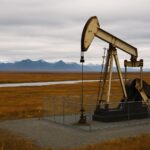The US Department of the Interior stated in Washington, officially announced the restart of the oil and gas development plan in the northern region of Alaska, according to the latest news, which includes the reopening of large-scale exploration projects in parts of the Arctic National Wildlife Refuge (ANWR) and the National Petroleum Reserve (NPRA). This move indicates that the US energy policy has once again shifted towards the “energy independence and capacity expansion” route, and also marks that, against the backdrop of global energy price fluctuations and international geopolitical tensions, the US will once again strengthen its domestic energy strategy.
Event time and background
On October 23, 2025, US Interior Secretary Deb Haaland announced that the US government would approve the resumption of oil and gas leasing activities on approximately 1.56 million acres of coastal plains along the North Slope of Alaska. These areas were originally part of the Arctic National Wildlife Refuge (ANWR) and have been suspended from development since the previous administration due to ecological protection disputes.
The announcement shows that the new development plan will be implemented by the Bureau of Land Management under the US Department of the Interior, and it is expected that the lease auction process will be restarted in the coming months. Meanwhile, about 82% of the land in the National Oil Reserve – Alaska (NPR-A) will also be reopened for oil and gas exploration and production.
Policy content and main measures
According to the detailed rules released by the Ministry of the Interior, the Alaska oil and Gas development plan includes the following key contents:
- Resumption of previously suspended lease contracts – The lease contracts previously signed by the Alaska Industrial Development and Export Authority (AIDEA) will come back into effect.
- Expand the open area of oil and gas blocks – approximately 1.56 million acres of Arctic coastal plains will be included in new lease zones.
- Optimize energy infrastructure – Federal and local governments will jointly plan new pipelines, oil storage facilities, and maritime transportation channels.
- Upgrading of Energy Independence Strategy – The US government has proposed the “2030 Energy Independence Roadmap”, planning to increase crude oil self-sufficiency by more than 5% through the Alaska project.
The White House energy advisor said that this policy “aims to reduce the United States’ reliance on energy from the Middle East and Russia and ensure domestic supply security”, and emphasized that the project is expected to create more than 10,000 direct or indirect jobs.
Policy drivers: Energy security and economic pressure
Analysts believe that the United States’ decision to resume oil and gas development in Alaska at this time is closely related to changes in the international energy situation. Since the global crude oil price remained at a high level in 2024, the inflation level in the United States has once again been affected by the rising energy costs, and domestic gasoline prices have repeatedly hit new highs.
Against this backdrop, the government has decided to “trade production capacity for stability”. Data from the Energy Economics Research Institute (EIA) shows that northern Alaska has oil and gas reserves of up to 11 billion barrels, making it one of the energy regions with the highest potential development value in the United States. Long-stalled development projects are regarded as the “dormant assets” of a country’s energy structure.
Furthermore, as the new energy industry has not yet completely replaced fossil fuels, the US government is seeking a balance between energy transition and the actual supply and demand. A White House spokesperson pointed out: “We remain firmly committed to promoting renewable energy, but it must be acknowledged that in the short term, oil remains the cornerstone of national security.”

Political and social responses
As soon as this decision was announced, it immediately triggered a strong reaction within the United States.
Supporters believe that the oil and gas projects in Alaska will bring about economic recovery and energy security. Alaska Governor Mike Dunleavy said, “This decision is a victory we have been waiting for many years and will revitalize the state’s economy, boost employment, and increase tax revenue.” Republican lawmakers also generally agree, believing that “restarting development is in the national interest and can withstand international energy risks.”
The opposition was equally strong. Environmental protection organizations and indigenous representative groups condemned this policy as “a regression to the ecology”. The environmental organization “Earth Guardians Alliance” pointed out that the ANWR region is home to rare species such as polar bears, reindeer, and snow geese, and development activities will disrupt its ecological balance. A representative of the local indigenous Inuit community said, “The government plundered the land in the name of the economy, but ignored our coexistence with this land for thousands of years.”
Several environmental protection agencies have indicated that they will file lawsuits in an attempt to prevent a new round of leasing activities through federal courts.
International influence and energy landscape
From an international perspective, the decision of the United States may have a significant impact on the global energy market. If the project is fully implemented, the daily output of oil in the United States is expected to increase by approximately 200,000 barrels, which will further consolidate its position as a global energy exporter.
However, this move is also regarded as a challenge to the climate goals of the Paris Agreement. A spokesperson for the United Nations Climate Action Agency said, “The Alaska development plan may increase ecological risks in the Arctic and undermine the global carbon reduction process.” Environmental groups in many European countries have expressed concerns over this, believing that the United States “has made a strategic setback in its climate responsibility”.
In addition, analysts point out that this policy may also become an opportunity for energy cooperation between the United States and Canada. Canada’s Arctic transportation ports and the crude oil export channel in Alaska may be reactivated to form a new Arctic shipping economic circle.
Follow-up outlook: Moving forward amid disputes
Despite continuous controversies, the US Department of the Interior emphasized that all development activities will be “carried out under strict environmental assessment”. The government plans to establish an independent regulatory committee to ensure that exploration activities comply with ecological protection and safety standards.
However, experts point out that construction in the Arctic region is extremely difficult. Natural conditions such as low temperatures, permafrost, and seasonal polar nights will prolong the construction period and increase costs.
Environmental scholar Mary Hughes said, “Alaska development is not only an energy game, but also a test of climate and politics.”
Currently, the first phase of the Alaska project – geological exploration and environmental assessment – is expected to commence in early 2026. If all goes well, the first batch of production Wells may come on stream before 2030.
Conclusion
The United States’ resumption of its oil and gas development plan in Alaska not only reflects its economic and energy strategy but also reveals the sharp contradiction between development and ecology in contemporary society.
This decision will undoubtedly bring new vitality to Alaska’s economy, but it will also test the government’s ability to strike a balance between environmental protection and global climate commitments.
In the coming years, the debate over “resource utilization” and “ecological conservation” will continue, and Alaska, this Arctic permafrost, will once again become the focus of global energy and environmental politics.












Leave a comment